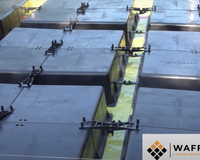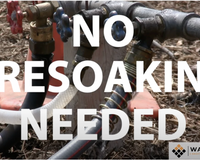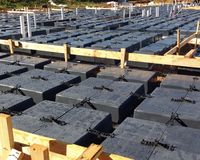A SOIL FOUNDATION WITH EXISTING SITE CONDITIONS VS IMPROVED SITE CONDITIONS
Texas soils vary greatly in nature, most of the good soil sites are taken, and as a result, we are left with highly expansive sites.
Common, yet expensive, options are to:
- Stabilize the expansive soils by moisture conditioning
- Remove and replace the soils
- Treat the clay with chemical injections.
These options can be extremely expensive and time consuming.
Here is the problem:
Clay soils expand and contract, depending on the amount of moisture it has been exposed to. The variations of potential movement can be measured up to 12” in some highly expansive areas.
When a ridged concrete foundation is poured without the proper design recommendations and analysis of the site conditions, it can result in structural failure cracks that will be noticeable in the slab, as well as the walls, ceilings, exterior finishes, and door and window openings.
How do we solve it?
Engineers are continuously exploring options on how to effectively address this issue. Typically, what has historically been done has been to excavate 10 feet (depending on how expansive the soil is) and fill the building pad area with 8” lifts of geo recommended fill, and achieving proper compaction with moisture conditioning.
The intent is to keep the soil hydrated is to allow the soil to expand at its full capacity prior to pouring the concrete slab. At the top of the building pad, approximately 12”-24” from the surface, non-expansive soil called select fill and or road base is imported as a cap. The purpose of select fill is to maintain the moisture in the lower 8‘-9’ in its expanded condition, and limit the possibility for soil expansion.
After the slab has been poured, the soil should remain stable. If the soil moisture conditions change, it will be the result of moisture loss, causing the soils to shrink rather than expand. The building area consists of the building footprint with a minimum of a 5’ expansion beyond the building perimeter.
On average, the cost for this process in time and expense is significant.
Case Study:
A case study was done to assess a 67,000 sq ft commercial building in Crowley Texas. The recommended soil remediation cost $230,000 and took a month to complete.
The delay in construction for a job this size translated into an additional fee of $150,000 per month. A total cost of $380,000 was incurred prior to any concrete being poured on the site, an additional $5.67 per sq ft.
Solution: The Wafflemat Foundation System
Wafflemat value engineered the project after its completion, and found that although Wafflemat cost $1/sq ft more than a conventional slab-on-grade, the total net savings for this project could have been $313,000 by alleviating the building pad requirements.
Using Wafflemat's void form foundation solution, this project could have avoided costly soil remediation and delays in construction.
Wafflemat was developed by a concrete contractor and analyzed by engineers to allow for an alternate approach on how slabs can be efficiently designed, in a safe and timely manner. This is just one reason why Wafflemat is the next evolution in foundation design.





